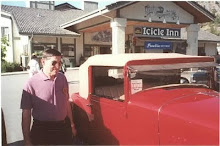Oops, sorry to interrupt, now back to the story
The Walla Walla Clinic had hired some new doctors.
The one assigned to Jean took me aside and asked me why I had traveled to Portland for care when we had such a great medical school in Seattle.
I found that these guys also had personal contacts at U.W. Med. School.
With problems still persisting we made an appointment and checked in.
The first thing done after the patient was signed in, had blood drawn, and set up in a room was a visit from a young resident. He had a tray with a kit and as he informed me that he had never done the procedure before, I opted to stay and watch.
I learned why visitors are asked to leave the room while the doctor is working.
The resident had Jean sit up and turn her back to him. He then selected a hypodermic needle and counted down the ribs. After marking the spot he pushed the needle into the marked spot and removed the plunger part allowing the almost clear spinal fluid to flow into a beaker.
He explained the importance of using just the right size needle to control the flow.
He went on to explain that in the original surgery the Oregon neurosurgeons had run the drain from the shunt into the thorax where a protein reaction had ensued causing a buildup of the spinal fluid requiring, I believe it was called thorocentesis, removal at least a litre of spinal fluid.
A new surgery was done utilising the stub into the brain but using an updated pump and a tubing size that maintained a pressure closer to her natural pressure.
Also the tube was fed into the atrium of the heart so the fluid would be carried in the bloodstream.
The Walla Walla Clinic had hired some new doctors.
The one assigned to Jean took me aside and asked me why I had traveled to Portland for care when we had such a great medical school in Seattle.
I found that these guys also had personal contacts at U.W. Med. School.
With problems still persisting we made an appointment and checked in.
The first thing done after the patient was signed in, had blood drawn, and set up in a room was a visit from a young resident. He had a tray with a kit and as he informed me that he had never done the procedure before, I opted to stay and watch.
I learned why visitors are asked to leave the room while the doctor is working.
The resident had Jean sit up and turn her back to him. He then selected a hypodermic needle and counted down the ribs. After marking the spot he pushed the needle into the marked spot and removed the plunger part allowing the almost clear spinal fluid to flow into a beaker.
He explained the importance of using just the right size needle to control the flow.
He went on to explain that in the original surgery the Oregon neurosurgeons had run the drain from the shunt into the thorax where a protein reaction had ensued causing a buildup of the spinal fluid requiring, I believe it was called thorocentesis, removal at least a litre of spinal fluid.
A new surgery was done utilising the stub into the brain but using an updated pump and a tubing size that maintained a pressure closer to her natural pressure.
Also the tube was fed into the atrium of the heart so the fluid would be carried in the bloodstream.


1 Comments:
You continue to amaze me-now I know where Mike gets his amazing memory. I am printing your writings so we will have them forever-incase computers are obsolete some day!
:)Debra
Post a Comment
<< Home